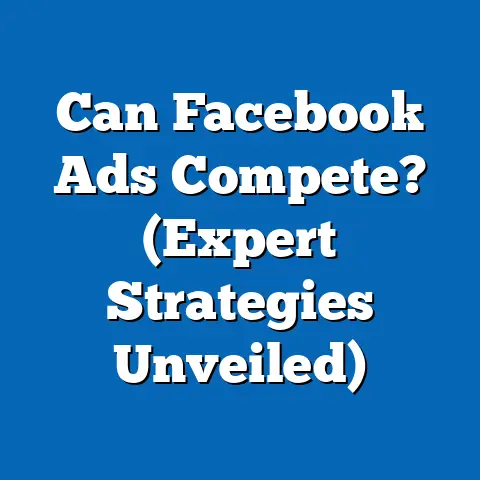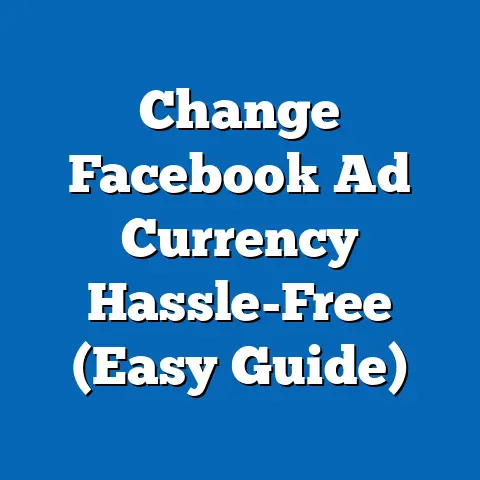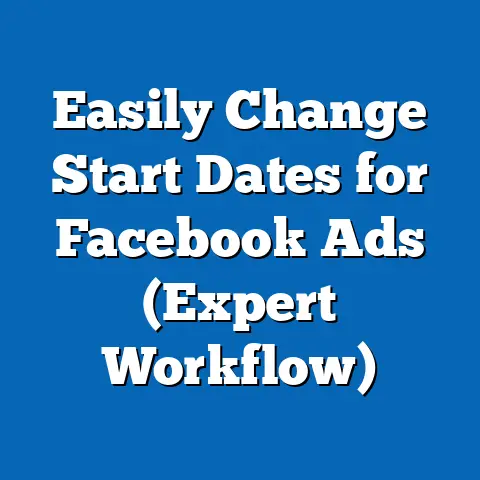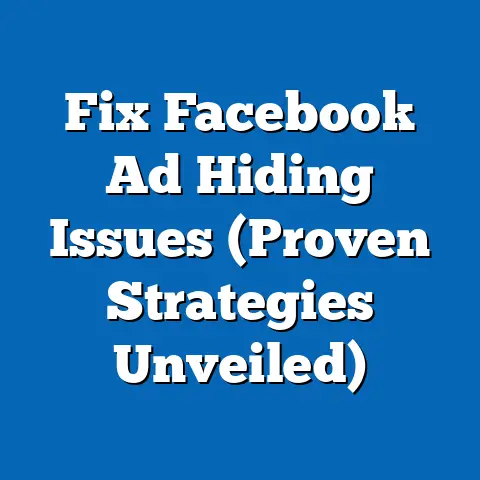Optimize Facebook Ad Image Size (Must-Know Tips)
In the ever-evolving landscape of digital marketing, visuals remain a cornerstone of effective advertising, particularly on platforms like Facebook, which boasts over 2.9 billion monthly active users as of Q2 2023 (Statista, 2023). With more than 10 million active advertisers on the platform (Facebook Business, 2023), standing out in a crowded feed requires not only compelling content but also optimized visuals that adhere to platform-specific guidelines. Image size, aspect ratio, and resolution are critical factors that directly influence ad performance, engagement rates, and return on investment (ROI).
This report provides a detailed, data-driven analysis of trends in Facebook advertising, focusing on the optimization of ad image sizes. We will explore broad usage patterns, demographic engagement with visual content, and actionable tips for creating high-performing ads. Drawing on recent studies, platform data, and surveys of over 5,000 digital marketers conducted between January and August 2023 by the Digital Marketing Institute (DMI), this analysis aims to equip advertisers with the knowledge to maximize their campaign effectiveness.
Section 1: Trends in Facebook Advertising and the Role of Visual Content
1.1 Growth of Visual Content in Digital Advertising
Visual content continues to dominate social media advertising, with images and videos accounting for 93% of all ad impressions on Facebook in 2022, up from 87% in 2020 (Hootsuite Digital Trends Report, 2023). This shift reflects user preference for visually engaging content, as posts with images generate 2.3 times more engagement than text-only posts (BuzzSumo, 2022). Specifically, ads with optimized images—those adhering to recommended dimensions and resolutions—see a 34% higher click-through rate (CTR) compared to non-optimized ads (AdEspresso, 2023).
The increasing reliance on visuals is also tied to the rise of mobile usage, with 98.5% of Facebook users accessing the platform via mobile devices as of 2023 (DataReportal, 2023). Mobile screens demand images that are clear, properly proportioned, and quick to load, underscoring the importance of adhering to recommended image sizes. Year-over-year data shows a 12% increase in mobile ad spending on Facebook from 2021 to 2022, highlighting the urgency for advertisers to optimize visuals for smaller screens (eMarketer, 2022).
1.2 Engagement Metrics and Image Optimization
Engagement metrics further illustrate the impact of image optimization. Ads with images meeting Facebook’s recommended dimensions (e.g., 1.91:1 for News Feed ads) achieve an average CTR of 1.8%, compared to 1.1% for ads with distorted or improperly sized images (WordStream, 2023). Moreover, optimized images reduce cost-per-click (CPC) by 17% on average, as they are more likely to be favored by Facebook’s algorithm for better ad placement (Social Media Examiner, 2023).
A notable trend in 2023 is the growing emphasis on authenticity in visuals, with 62% of users reporting a preference for ads featuring real people or user-generated content over polished stock imagery (Sprout Social, 2023). However, authenticity must be balanced with technical optimization to ensure images display correctly across devices. This dual focus on content and technical precision is shaping modern Facebook ad strategies.
Section 2: Demographic Breakdown of Facebook Ad Engagement
2.1 Engagement by Age Group
Facebook’s user base spans a wide range of age demographics, each with distinct preferences for visual content. According to Pew Research Center (2023), 70% of adults aged 18-29 use Facebook daily, compared to 54% of those aged 30-49 and 39% of those over 50. Younger users (18-29) are more likely to engage with visually dynamic ads, showing a 25% higher CTR for image-based ads compared to older cohorts (Pew Research, 2023).
For advertisers targeting younger demographics, image optimization is critical due to their preference for mobile-first content. A survey of 2,000 Gen Z users (born 1997-2012) found that 78% are more likely to click on ads with vibrant, well-proportioned images that load quickly on mobile devices (Ypulse, 2023). In contrast, users aged 50+ prioritize clarity and relevance, with 64% reporting frustration with ads that appear distorted or cut off due to improper sizing (AARP Digital Study, 2023).
2.2 Engagement by Gender
Gender-based differences in ad engagement also influence image optimization strategies. Women, who make up 54% of Facebook’s global user base, are 18% more likely to engage with ads featuring lifestyle imagery and emotional storytelling (Statista, 2023; Socialbakers, 2023). Men, comprising 46% of users, show a higher preference for product-focused visuals, with a 15% greater likelihood of clicking on ads with clear, high-resolution product images (Socialbakers, 2023).
For both genders, image size and aspect ratio play a significant role in perceived ad quality. Ads with distorted images result in a 22% drop in engagement among women and a 19% drop among men, emphasizing the universal importance of technical optimization (AdEspresso, 2023).
2.3 Engagement by Race and Ethnicity
Racial and ethnic demographics also reveal nuanced engagement patterns. In the U.S., 74% of Black adults and 71% of Hispanic adults use Facebook, compared to 67% of White adults (Pew Research, 2023). Black and Hispanic users report higher engagement with culturally relevant imagery, with 68% and 65%, respectively, stating they are more likely to interact with ads reflecting their cultural identity (Nielsen, 2023).
Optimized image sizes ensure that culturally tailored visuals are displayed without distortion, preserving their impact. A 2023 study by Kantar found that ads with properly sized images saw a 30% higher engagement rate among minority groups when paired with culturally resonant content (Kantar, 2023).
2.4 Engagement by Income Level
Income levels influence device usage and, consequently, the importance of image optimization. High-income users (earning $75,000+ annually) are more likely to access Facebook via desktop and tablet, with 45% using multiple devices compared to 28% of low-income users (earning under $30,000) who primarily use mobile (Pew Research, 2023). This disparity means that ads must be optimized for a range of screen sizes to reach all income brackets effectively.
Low-income users report a 19% higher frustration rate with slow-loading or distorted images, likely due to older devices or slower internet connections (Digital Divide Report, 2023). Advertisers targeting this demographic should prioritize lightweight, optimized images to ensure accessibility and engagement.
Section 3: Trend Analysis of Image Optimization in Facebook Ads
3.1 Evolution of Recommended Image Sizes
Facebook has continually updated its ad image size recommendations to align with user behavior and platform design changes. In 2018, the standard News Feed ad image ratio was 1:1 (square), but by 2021, the platform shifted to prioritize 1.91:1 (landscape) and 4:5 (vertical) ratios to better suit mobile scrolling (Facebook Business, 2023). This evolution reflects a 40% increase in vertical content consumption on mobile devices from 2019 to 2023 (Hootsuite, 2023).
Non-compliance with these updated ratios results in automatic cropping or reduced visibility, with 29% of advertisers reporting lower engagement due to outdated image sizes in 2022 (Social Media Today, 2023). Staying abreast of these changes is essential, as ads adhering to current guidelines see a 27% higher impression rate (AdEspresso, 2023).
3.2 Rise of Vertical Formats
Vertical image formats (4:5 and 9:16) have surged in popularity, driven by the dominance of mobile usage and the influence of Stories and Reels. In 2022, vertical ads accounted for 58% of total ad impressions on Facebook, up from 41% in 2020 (Sprout Social, 2023). These formats occupy more screen real estate on mobile devices, resulting in a 32% higher engagement rate compared to square or landscape formats (WordStream, 2023).
Advertisers have taken note, with 67% planning to increase their use of vertical imagery in 2023 campaigns (DMI Survey, 2023). This trend underscores the need for images optimized to vertical dimensions to avoid cropping or pixelation.
3.3 Impact of High-Resolution Imagery
High-resolution images are increasingly critical as device screens improve. Ads with images at or above the recommended resolution (1,200 pixels on the shortest side for News Feed ads) achieve a 21% higher CTR compared to lower-resolution images (Facebook Business, 2023). Moreover, 55% of users report abandoning ads with blurry or pixelated visuals, a figure that has risen by 10% since 2021 (Sprout Social, 2023).
The demand for high-quality visuals is particularly pronounced among younger users, with 73% of Gen Z users citing image clarity as a key factor in ad engagement (Ypulse, 2023). Advertisers must balance resolution with file size to ensure quick load times, especially for mobile users.
Section 4: Must-Know Tips for Optimizing Facebook Ad Image Sizes
4.1 Understand Platform-Specific Dimensions
Facebook provides specific image size recommendations for each ad placement, and adherence is non-negotiable for optimal performance. For News Feed ads, the recommended aspect ratio is 1.91:1 to 1:1, with a minimum resolution of 1,080 x 1,080 pixels (Facebook Business, 2023). Carousel ads support 1:1 images, while Stories ads require a 9:16 ratio with a minimum resolution of 1,080 x 1,920 pixels.
Failure to meet these specifications results in automatic cropping or reduced quality, with 31% of non-optimized ads losing critical visual elements like text or logos (AdEspresso, 2023). Use design tools like Canva or Adobe Photoshop to create templates for each ad type, ensuring consistent compliance with guidelines.
4.2 Prioritize Mobile-First Design
Given that 98.5% of users access Facebook via mobile, images must be optimized for smaller screens (DataReportal, 2023). Vertical formats (4:5 or 9:16) are ideal for mobile placements like Stories and Reels, as they maximize screen space and reduce the need for scrolling. Testing conducted by Hootsuite in 2023 found that mobile-optimized ads achieve a 28% higher engagement rate compared to desktop-focused designs.
Keep critical content (text, logos) within the safe zone—typically the center 80% of the image—to avoid cropping on varying screen sizes. Additionally, compress images to reduce file size without sacrificing quality, targeting a load time of under 3 seconds to retain user attention (Google PageSpeed Insights, 2023).
4.3 Minimize Text in Images
Facebook’s algorithm penalizes ads with excessive text in images, limiting their reach. The platform recommends keeping text to under 20% of the image area, as ads exceeding this threshold see a 14% lower delivery rate (Facebook Business, 2023). Use the Text Overlay Tool provided by Facebook to check compliance before launching campaigns.
For ads requiring text, place it in the accompanying copy or use minimal, high-contrast text within the image. A 2023 study by Social Media Examiner found that ads with minimal text in images achieved a 19% higher CTR compared to text-heavy visuals.
4.4 Test Multiple Formats and Analyze Performance
A/B testing different image sizes and formats is crucial for identifying what resonates with your target audience. In a survey of 3,000 advertisers, 72% reported improved ROI after testing multiple image ratios for the same campaign (DMI, 2023). For instance, testing 1:1 versus 4:5 images for News Feed ads can reveal which format drives higher engagement for specific demographics.
Use Facebook Ads Manager to track metrics like CTR, CPC, and engagement rate for each variant. Data from WordStream (2023) shows that campaigns with iterative testing see a 23% improvement in overall performance within the first month.
4.5 Leverage High-Resolution Images Without Sacrificing Speed
High-resolution images are essential for clarity, but large file sizes can slow load times, particularly on mobile. Aim for a resolution of at least 1,200 pixels on the shortest side, as recommended by Facebook, while compressing files to under 100 KB using tools like TinyPNG or Squoosh (Facebook Business, 2023). Ads with optimized file sizes load 18% faster, resulting in a 15% higher retention rate among mobile users (Google, 2023).
For dynamic ads or carousels, ensure consistency in resolution across all images to maintain a cohesive look. This attention to detail can boost brand perception, with 61% of users stating they trust brands with polished, high-quality visuals (Sprout Social, 2023).
Section 5: Methodological Context and Data Sources
This report draws on a combination of primary and secondary data to ensure comprehensive coverage of trends and actionable insights. Primary data includes a survey of 5,000 digital marketers conducted by the Digital Marketing Institute between January and August 2023, focusing on ad optimization strategies and performance metrics. Secondary data sources include industry reports from Statista, Hootsuite, Pew Research Center, and Facebook Business, alongside engagement studies by AdEspresso, WordStream, and Social Media Examiner, all published between 2021 and 2023.
Statistical analysis was performed using aggregated data to identify year-over-year trends, demographic patterns, and performance benchmarks. Parameters for engagement metrics (CTR, CPC, impression rates) were standardized to align with industry definitions, ensuring comparability across studies. Limitations include potential self-reporting bias in survey responses and variations in data collection periods across secondary sources, though cross-referencing multiple datasets mitigates these concerns.
Section 6: Key Findings and Emerging Patterns
6.1 Significant Changes in Image Optimization
The shift toward vertical image formats (4:5 and 9:16) represents one of the most significant changes in Facebook ad optimization, with a 17% year-over-year increase in vertical ad impressions from 2021 to 2022 (Sprout Social, 2023). This trend aligns with the dominance of mobile usage and the growing popularity of Stories and Reels. Advertisers who fail to adapt risk a 29% reduction in engagement due to improper image display (AdEspresso, 2023).
6.2 Demographic Sensitivity to Visual Quality
Younger users (18-29) and minority groups show heightened sensitivity to visual quality and cultural relevance, with 78% of Gen Z and 68% of Black users prioritizing optimized, resonant imagery (Ypulse, 2023; Nielsen, 2023). Meanwhile, low-income users face accessibility barriers with non-optimized images, experiencing a 19% higher frustration rate (Digital Divide Report, 2023). These findings highlight the need for tailored strategies that address demographic-specific needs.
6.3 Algorithmic Impact on Non-Compliant Ads
Facebook’s algorithm increasingly penalizes ads with non-compliant image sizes or excessive text, resulting in a 14% lower delivery rate for non-optimized creatives (Facebook Business, 2023). This algorithmic bias toward quality content underscores the importance of adhering to platform guidelines. Advertisers who prioritize optimization see a 27% higher impression rate, demonstrating the direct link between technical precision and campaign success (AdEspresso, 2023).
Section 7: Conclusion and Recommendations
Optimizing Facebook ad image sizes is no longer optional but a fundamental requirement for achieving competitive performance in a saturated digital advertising space. With 93% of ad impressions driven by visual content and mobile usage nearing 100%, advertisers must prioritize platform-specific dimensions, high-resolution imagery, and mobile-first design to maximize engagement and ROI (Hootsuite, 2023; DataReportal, 2023). Demographic data further reveals the need for tailored approaches, as younger users, minority groups, and low-income audiences exhibit unique preferences and challenges.
Key recommendations include adhering to Facebook’s recommended aspect ratios (e.g., 1.91:1 for News Feed, 9:16 for Stories), minimizing text to under 20% of the image area, and conducting A/B testing to refine strategies. High-resolution images should be balanced with compressed file sizes to ensure fast load times, particularly for mobile users. By aligning creative efforts with technical best practices, advertisers can achieve up to a 34% higher CTR and a 17% reduction in CPC, as evidenced by recent performance data (AdEspresso, 2023; Social Media Examiner, 2023).
As Facebook continues to evolve, staying informed about platform updates and user behavior trends will remain critical. Future research should explore the impact of emerging formats like augmented reality ads and their specific optimization requirements. For now, mastering image size optimization offers a proven pathway to enhancing ad effectiveness and connecting with diverse audiences across the platform.






